Brushing and flossing
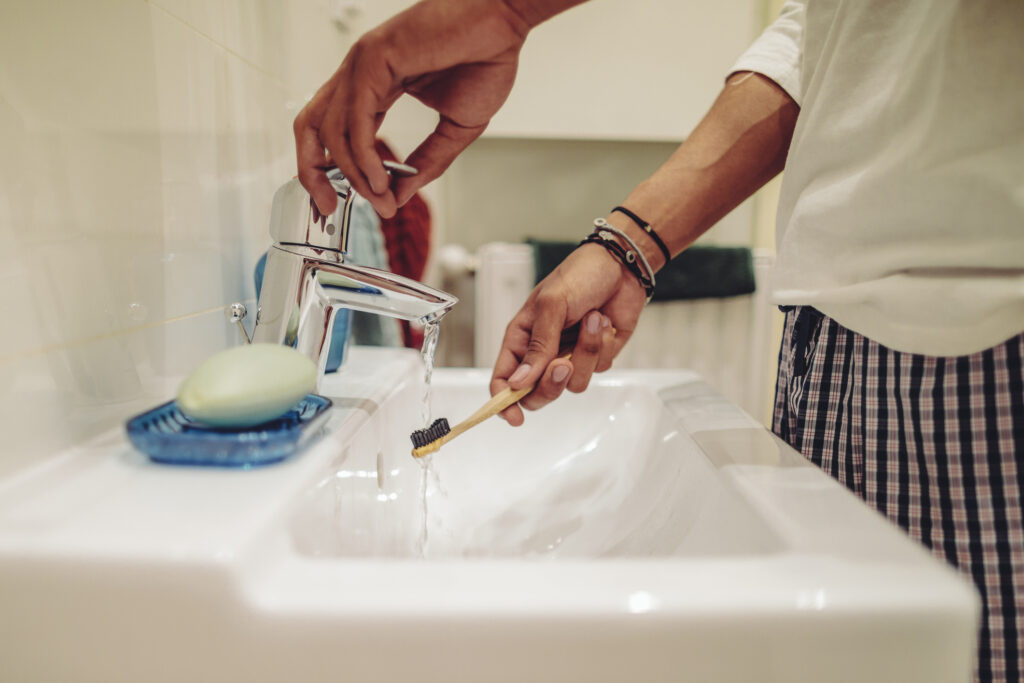
-
Food particles and plaque naturally accumulate on the teeth and on braces. This process could lead to tooth decay and/or gum disease. Proper oral hygiene is vital to prevent these problems from occurring during your orthodontic treatment. The extra effort you give to keep your teeth, braces and gums clean and healthy will result in a much better orthodontic outcome. Remember we will gladly provide a new toothbrush when you need it. Just let our staff know.
-
Brushing
Our doctors recommend that you use a soft-bristled toothbrush with moderate force and toothpaste that contains fluoride. Place the toothbrush at an angle so that you feel the bristles under your gum line and use small circular motions. Completely clean each surface of every tooth in your mouth, including the areas above, below and between each brace. Each surface of every tooth should be scrubbed with 10 strokes of the toothbrush. This should take 2-3 minutes.
Drs. Blackman, McCormack and Theivakumar recommend that you brush at least 4 times per day: after breakfast, after lunch (or as soon as you get home from school), after supper and at bedtime. Your toothbrush will wear out faster because of your appliances, so be sure to replace it whenever the bristles start to fray.
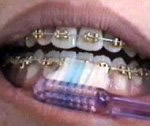
1. Use a soft toothbrush with a small amount of toothpaste. Completely clean each surface of every tooth in your mouth, including the areas above, below and between each brace.
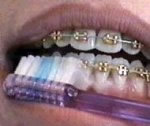
2. Use circular, vibrating motions around the gum line. Scrub each surface of every tooth with 10 strokes of the toothbrush. This should take 2-3 minutes.
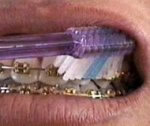
3. Brush every tooth slowly. Brush the upper teeth down.
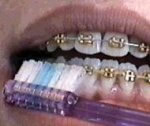
4. Brush the lower teeth up. Also, brush your tongue and the roof of your mouth.
Remember that a toothbrush might not reach the areas under the archwire properly. Proper oral hygiene also involves flossing and the use of an interdental toothbrush (Proxabrush), an antiseptic mouth rinse (Peroxyl) and a topical fluoride (Perio-Med)!
-
Flossing
Dental floss is a nylon thread that is used to remove food particles and plaque from between the teeth. Flossing is more difficult when you have braces on your teeth. A floss threader may be needed to get the floss under the archwire. The doctors will provide these for you (note: floss threaders are reusable). Use a piece of floss about 12 inches long. Use the floss threader to get the floss under the wire. Slide the floss up and down along the tooth surface. When the tooth is clean the floss will “squeak” as you slide it up and down along the tooth surface. Be very careful to not pull with too much force on your archwire.
Flossing is important and should be done every day. The best time to floss is before bedtime after brushing to remove the plaque missed by brushing. This process will take more time than flossing without braces. If your gums are not healthy, they may bleed the first few days you floss. Remember that consistent brushing and flossing will result in a great orthodontic smile!
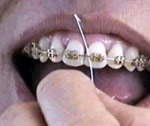
1. Carefully pull waxed floss between the wire and braces.
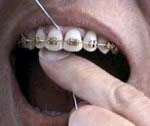
2. Floss carefully around the gum area.
-
Interdental toothbrush
An interdental toothbrush (Proxabrush) is another aid you may find useful to keep your teeth, braces and gums clean and healthy. It can be used to clean under orthodontic wires and around braces. Use this device slowly so you do not damage your braces.
-
Antiseptic mouth rinse (Peroxyl)
Peroxyl is an antiseptic dental rinse (active ingredient: hydrogen peroxide 1.5%) used in orthodontics to control minor gum inflammation and irritations from orthodontic appliances. It is also used to cleanse canker sores and minor wounds or other irritations of the mouth and gums such as mouth burns, cheek bites and toothbrush abrasions. Its oxygenating action removes debris allowing natural healing to occur.
-
Fluoride
Our orthodontists recommend the use of prescription fluoride. We will prescribe the gel we recommend for you to use. Use fluoride gel instead of toothpaste at nighttime. After brushing, spit out the excess fluoride and do not rinse. Fluoride must stay on the teeth all night to provide the ultimate protection against decalcification (white spots).
-
Cleaning a removable appliance
All orthodontic appliances tend to accumulate food particles and plaque just like teeth do. Every time you brush your teeth, brush your removable appliance. Once a day you should soak your appliance in a glass of room-temperature tap water with a denture-cleaning tablet, such as Polident or Efferdent. This will help prevent plaque buildup and oral infections and will keep your appliance tasting better.
